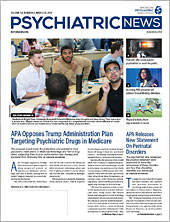To improve outcomes for women and their families, APA issued a new position statement to encourage physicians across all specialties to better detect, diagnose, and treat mood and anxiety disorders in pregnant and postpartum women.
The “Position Statement on Screening and Treatment of Mood and Anxiety Disorders During Pregnancy and Postpartum” was approved by APA’s Board of Trustees at its December 2018 meeting.
“Perinatal depression is one of the most common complications of giving birth,” said Jennifer L. Payne, M.D., director of the Women’s Mood Disorders Center and an associate professor of psychiatry at Johns Hopkins School of Medicine. As many as 1 of 7 pregnant women and as many as 1 of 5 pospartum women develop depressive or anxiety disorders, according to the position statement.
More serious mental health problems are associated with the perinatal period: 1 of 1,000 such women develops a psychotic disorder, and maternal suicide is the second-leading cause of death among postpartum women. The incidence of perinatal psychiatric disorders is highest in women from lower socioeconomic backgrounds.
“We want to make abundantly clear the seriousness of these disorders and explain how we must address them to avoid deleterious effects on infant development, including preterm birth, low birth weight, lower IQ, slower language development, and more child behavioral problems,” Payne said. “It impacts more than just the mom. It really becomes a public health problem in a way—it becomes about the whole family.”
A blue-ribbon panel of 12 reproductive psychiatrists, including some of the top research psychiatrists in the country, began working together on the position statement two years ago. They drew from more than 450 reference materials, including their own research articles.
“We discovered there were so many untreated and undiagnosed cases of antenatal and postpartum psychiatric disorders,” explained Maureen Sayres Van Niel, M.D., president of the APA Women’s Caucus and a member of the Steering Committee of the Women’s Preventive Services Initiative, who spearheaded APA’s effort.
“A number of major medical organizations had already developed position statements and were looking to APA for guidance,” Sayres Van Niel explained. “APA wants to be a leader in educating physicians in finding and diagnosing these disorders and helping providers to establish some sort of mechanism for following up when a screening comes back positive.”
Formal Screening Tools Boost Detection
Recent studies of obstetrician/gynecologists have found a significant improvement in the detection rates of depressive and anxiety disorders for this patient population—in some cases more than 20 percent—when they use formal assessment tools. “But most ob-gyn and primary care physicians rely solely on a clinical interview and their own judgment,” Sayres Van Niel said.
“Many of the women who suffer from these disorders feel shame and guilt. They think that with a pregnancy or new baby, they’re supposed to feel only happy and positive about the experience, so they don’t tell people,” Sayres Van Niel said. “But with a screening tool, women can complete it in the waiting room, in privacy, and they may be more forthcoming.”
Among free screening tools with good sensitivity and specificity, Payne and Sayres Van Niel recommended the one-page Edinburgh Postnatal Depression Scale (EPDS) accompanied by an anxiety screening tool, such as the Generalized Anxiety Disorder 7-item scale (GAD-7).
Payne pointed out that when it comes to treating this patient population, women are often advised when they are pregnant to give up coffee, alcohol, and their antidepressants.
“This is due to a misunderstanding of how serious psychiatric illnesses are,” she said. “Antidepressants are not a ‘luxury’ medication.”
Most Antidepressant Use Safe in Pregnancy
Some studies have associated pregnant women’s use of antidepressants with higher rates of infant heart defects, hypertension, and autism, Payne explained. But when studies were well controlled for the health risks associated with depression (women with depression have higher rates of smoking, substance use, diabetes, obesity, cardiovascular disease, and use of other medications), antidepressants were not associated with increased risks for the infant.
“It’s incredibly reassuring to know that most psychotropic medications are reasonably safe during pregnancy and lactation,” Payne said. “But I think a lot of psychiatrists have not gotten that message, and we need to be talking more about that. When you look at the literature as a whole, it is clear there are abundant risks of having moms psychiatrically ill during pregnancy and postpartum, while the risks of antidepressant use during pregnancy is controversial.”
Ultimately, the position statement was needed given how common these disorders are, Sayres Van Niel said. “A woman experiencing mental health issues during pregnancy or after the birth of a baby should be educated that her condition is a medical illness—and that there are good treatments for it and that she is no less of a mother for experiencing it.” ■
APA’s “Position Statement on Screening and Treatment of Mood and Anxiety Disorders During Pregnancy and Postpartum” can be accessed
here.

